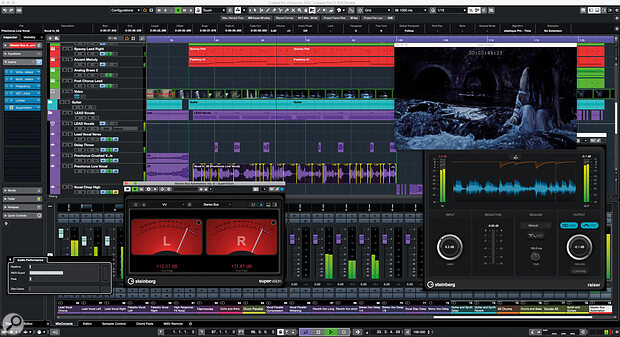Cubase gains new features and dispenses with the dongle.
Cubase’s substantial and diverse user base might have had to wait a few months beyond Steinberg’s regular end‑of‑year update cycle, but version 12 is now with us. Of course, in its Pro form, Cubase has been a sophisticated, feature‑rich music production platform for many years. So what have Steinberg added to v12 to improve upon their already‑impressive flagship product and to tempt existing users, and potentially new ones, to invest?
Licence To Roam
I’ll get to Cubase Pro 12’s list of additions in a minute but perhaps the item that caused the most chatter online prior to launch was actually something Steinberg was taking away; licensing via a dongle. USB dongles are something that engender very mixed feelings. If you primarily work in a fixed studio space (as I do), it’s perhaps not so much of an issue but, for those who are more mobile, looking after a dongle (or three) when you move between locations can be problematic.
Of course, all developers have to protect their software from piracy, but Steinberg obviously feel that that can now be done effectively without the eLicenser key. With v12, activation is linked to your host computer and you can activate on up to three different machines under a single license. This worked very smoothly for me when installing Cubase Pro 12 (although some users did report issues immediately after the launch, presumably caused by Steinberg’s servers being inundated with update requests) and I was able to install and activate on both my main studio machine (under Mac OS) and on a Windows‑based laptop I occasionally use for mobile work, without any problems. For understandable pragmatic reasons, Steinberg are planning to transition their other major software titles to the new licensing system as each goes through its own update cycle. Users of WaveLab or SpectraLayers, for example, will therefore have to wait a little longer to be completely eLicenser‑free, but it is coming.
Silicon Tally
Dongle‑free licensing aside, what’s new in Cubase Pro 12? Sensibly, Steinberg have adopted an evolutionary approach rather than a revolutionary one (existing workflows therefore remain intact) but, as befits a whole number upgrade, there is plenty of ‘new and improved’ to discuss.
 The Audio Performance meter has been improved — but Cubase 12 doesn’t seem to place any noticeable additional burden on your host system.For example, Apple‑based users will welcome the news that Cubase 12 has native support for Apple Silicon. That said, for those with a M1‑powered Mac, Rosetta is likely to remain a fact of life (albeit a fairly innocuous one) for a while yet as music software developers gradually embrace the chip format. It’s also worth noting that, amongst the brief ‘requirements’ list for Cubase 12, Steinberg’s website lists Mac OS Big Sur or Monterey. However, early user reports suggested plenty of folks running quite happily on older Mac OS iterations such as Catalina. For Windows‑based users, 64‑bit versions of either Windows 10 or Windows 11 are supported. Both Mac and Windows installs require 70GB of free storage space, and a minimum 8GB of RAM is suggested.
The Audio Performance meter has been improved — but Cubase 12 doesn’t seem to place any noticeable additional burden on your host system.For example, Apple‑based users will welcome the news that Cubase 12 has native support for Apple Silicon. That said, for those with a M1‑powered Mac, Rosetta is likely to remain a fact of life (albeit a fairly innocuous one) for a while yet as music software developers gradually embrace the chip format. It’s also worth noting that, amongst the brief ‘requirements’ list for Cubase 12, Steinberg’s website lists Mac OS Big Sur or Monterey. However, early user reports suggested plenty of folks running quite happily on older Mac OS iterations such as Catalina. For Windows‑based users, 64‑bit versions of either Windows 10 or Windows 11 are supported. Both Mac and Windows installs require 70GB of free storage space, and a minimum 8GB of RAM is suggested.
One further benefit of the new, dongle‑free licensing arrangements is that a trial version of Cubase is now possible. It was still listed as ‘coming soon...’ at the time of writing, but obviously will mean you can test Cubase 12 on your own hardware/OS without risk prior to making a purchase decision.
Software developments will, eventually and inevitably, leave older host systems behind. However, in use, Cubase Pro 12 felt very responsive on my now ageing 2013 iMac during the review period. Running some of my existing v11 projects under v12 created no obvious problems; if my experience is anything to go by, Cubase Pro 12 doesn’t seem to place any noticable additional demands on your computer host compared to v11.
You Hum It, I’ll Play It
Specific new additions or improvements may have differing appeal to different users but, in scanning Steinberg’s ‘what’s new?’ list prior to actually launching Cubase Pro 12, the new Audio To MIDI Chords option particularly caught my attention. The concept is simple enough; drag any audio recording to the Chord Track and Cubase will then analyse the audio, identify the underlying chord changes within it (this takes a few seconds), and place those changes as chord events within the Chord Track.
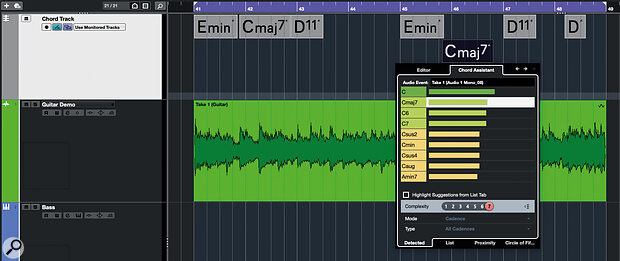 The Audio To MIDI Chords feature requires just a simple drag and drop operation, while the Chord Assistant’s new dedicated tab streamlines any subsequent finessing required after Cubase’s initial chord identification.
The Audio To MIDI Chords feature requires just a simple drag and drop operation, while the Chord Assistant’s new dedicated tab streamlines any subsequent finessing required after Cubase’s initial chord identification.
The applications are obvious. For example, those with limited music theory might use it to analyse a full mix or instrumental backing track to get a start on unpicking the key/chords, either for educational purposes, or to assist in any later remixing, mash‑up, or top‑line additions. You might also use it to extract the chords from a piano or synth loop so you can build other musical elements around it. Personally, however, I’d use it as a workflow enhancer to get the Chord Track populated with the chords from a new idea captured as a guitar recording (my instrument of choice), before dragging those chords off to something like Toontrack’s EZkeys or EZbass to flesh out the idea. Manually entering chords into the Chord Track is straightforward enough but can also be time consuming; having Cubase do this for me automatically is a very attractive prospect.
So, the concept is appealing, but does it actually work? Amazingly (well, I think it’s pretty amazing given what must be going on under the hood), the answer is mostly ‘yes’. Can you fool it with complex chords in a busy mix, weird chord extensions in a complex jazz piece, or bit of prog‑based strumming? Yes, you can. Might you sometimes find yourself having to go in and fine‑tune the automatic chord identification? Yes, you will.
However, even with these qualifications, the process works remarkably well. I tried it with the aforementioned guitar parts, some synth loops and some full mixes (my own and some well‑known commercial releases). As you might expect, the more straightforward the original performance, the more accurate the chord identification is likely to be but, whether perfect or not, as way of getting a first pass at the chord changes, and their entry into the Chord Track, this is a heck of a trick. In addition, even if you do find yourself needing to then finesse the results, editing chords within the Chord Track has been enhanced, with the Chord Assistant now including a new Detected tab. This gives you a prioritised list of chord alternatives that can easily be auditioned to see if they provide a better musical fit to the first choice that Cubase made on your behalf.
If your workflow doesn’t make use of the Chord Track, or your ear training is good enough to work out the chordal structure of a piece of music without any assistance from software, then this feature might not be such a big deal. For everyone else (myself included), this is a super‑useful addition and it’s available to Pro, Artist and Elements users.
Remote Control
Cubase has included support for external MIDI controllers for a very long time. Some of the previous features remain as legacy options, but the new MIDI Control Surface Editor and the associated Mapping Assistant, both accessed via a dedicated tab within the Project window’s Lower Zone, represent a considerable revamp. Preset configurations are included for a small number of popular controller devices, but a key aim of the new system is to make it easy for users to create their own preset for whatever controller device (or devices; the system support simultaneous use of multiple controllers) they have connected.
 The new MIDI Controller Editor and Mapping Assistant features — including the new Focus Quick Controls — provide a significant step forward for external MIDI controller integration.
The new MIDI Controller Editor and Mapping Assistant features — including the new Focus Quick Controls — provide a significant step forward for external MIDI controller integration.
This is a three‑step process completed via the new MIDI Remote tab within the Lower Zone. First, on opening this tab, you can click on the large ‘+’ icon to add a new controller and identify its appropriate MIDI ports. Second, you can then use the new MIDI Controller Surface Editor to graphically recreate the appropriate combination of buttons, rotary knobs and faders available on your hardware device. The editing tools let you easily position and scale individual controls to reflect the actual hardware layout. However, the key element of this second step is to establish links between each of the actual hardware controls and their respective graphical representations. A well‑implemented MIDI Learn system makes this one‑time process very straightforward.
The third step is where you link a Cubase control/command to each of the buttons, sliders and knobs. The new MIDI Remote Mapping Assistant dialogue lets you step through each of the controllers and, via the dialogue’s Functions Browser panel, link it to a Cubase command option. It’s both easy to do and flexible and, start to finish, I had the faders, buttons, transport controls and rotary knobs on my Novation Impulse controller configured in just a few minutes. This is a massive step forward from the previous Generic Remote system.
A new element introduced as part of this revamp is the appearance of what Steinberg have termed Focus Quick Controls. If your controller includes a set of eight rotary CC controllers (as my Impulse does), assigning these to the new Focus Quick Controls is particularly useful. Essentially, Focus Quick Controls automatically remap themselves to the Quick Controls of either the selected (‘in focus’) track or plug‑in window. There are options to lock the focus, or to give it either track or plug‑in priority, but the system is incredibly easy to use and seems more consistent than the previous Quick Control iteration.
For track‑level Quick Controls, you can still specify the targets via the Project window Inspector panel. However, rather brilliantly, a new QC button is located top‑right of every effect or instrument plug‑in window (whether Steinberg or third‑party) and these pop open a panel where you can define your plug‑in‑specific Quick Control targets. Once done, the rotary knobs on your hardware controller automatically ‘focus’ on the Quick Control assignments of the currently selected track or plug‑in window. It just works and, if your MIDI keyboard doesn’t currently include eight rotary knobs, this may be a good enough reason to add one that does.
Oh, and the final icing on the cake is that, for any connected controller, you can define multiple mapping pages. While you can only use one at any one time, you can easily switch between them; if you want different mappings for different types of task (for example, recording and mixing), that can easily be done.
Scale New Heights
Steinberg added the Scale Assistant functionality to the MIDI Key Editor in Cubase 11. It both speeds up routine MIDI editing (out‑of‑key notes can be avoided) and makes it easier to experiment with note combinations when creating harmonies/chords.
For the Pro and Artist editions of Cubase 12, exactly the same Scale Assistant functionality has now been added when editing audio pitches using VariAudio within the Sample Editor. This allows you to choose between the scale defined within the Chord Track or a scale selected within the VariAudio editor panel. If you go with the latter, then you can also specify the key/scale or choose from some options suggested by Cubase on the basis of the notes identified within the audio event being edited. You also get the same Scale Assistant options to change the note lane shading to emphasise the notes within the scale, enable pitch snapping when editing, and to pitch quantise selected notes.
 The Scale Assistant is now available within the VariAudio system.
The Scale Assistant is now available within the VariAudio system.
Whether it’s to assist your music theory, or simply to get to the correct notes faster, Scale Assisted audio editing brings a welcome workflow enhancement. And, while pitch quantising can obviously be used as part of your pitch‑correction process, where it really shines is in the speed/freedom it brings to experiment with either changing a melody or creating a harmony to a melody. In either case, with Snap Pitch Editing engaged, you instantly know that any edits you make will stay in key. It’s very slick and, given VariAudio’s excellent pitch‑shifting algorithms, the results can be very impressive indeed.
Request A Raise
Cubase’s stock plug‑in collection includes a range of very effective dynamics processors but, for Pro users, v12 adds a further single‑band option: Raiser. Described as a versatile limiter, as shown in the screenshot, the UI includes options that are familiar from earlier plug‑ins such as Maximiser or Brickwall Limiter (for example, Detect Intersample Clipping). However, there are also some different elements and Steinberg are keen to emphasise that Raiser offers some unique release time options.
The latter include very fast release times (you can specify a Time setting of 1.0ms), and a Fast button that provides a two‑stage release (an initial very fast phase followed by a second phase controlled by the Time setting). The Release drop‑down menu provides a number of different modes including Manual, Auto and Aggressive. There’s no threshold control; you simply use the Gain control to drive the input up against Raiser’s fixed threshold to get the peak limiting to kick in. The display gives a real‑time indication of the gain change upon the waveform and, interestingly, the release behaviour. This provides very useful visual feedback as you set the Release speed.
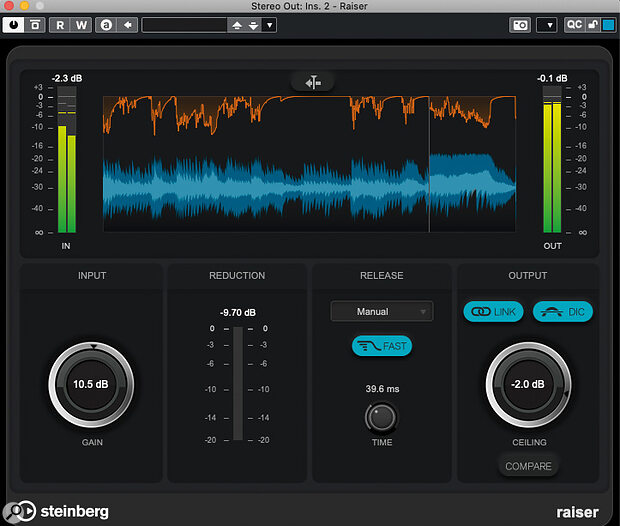 Raiser: things might get loud!
Raiser: things might get loud!
In use, Raiser makes it very easy to, er, raise the level of almost any type of signal. It works well on an individual instrument/vocal, a bus, or as a final limiter on your main stereo output. By balancing the input Gain and release Time controls, you can go from gentle, smooth dynamics control right through to very aggressive (and much louder) treatments. The Compare button lets you A/B the original and processed signals without the added loudness so you can also easily check for any undesirable consequences of the processing without being sucked in by ‘louder equals better’.
That said, things can get remarkably loud before the sonic consequences become obvious; as a means of levelling out a very dynamic source to ensure it sits consistently within a mix, Raiser does an impressive job. If supervised by SuperVision’s loudness metering, it’s also a very handy tool for fine‑tuning the overall level of a mix. And, whatever algorithm Steinberg have developed here to allow Raiser to operate with such fast release times, it’s not at the expense of latency; an instance of Raiser only added 2.6ms to the signal chain on my host system.
All Mod Cons: FX Modulator
 FX Modulator: tempo‑sync’ed multi‑effects with modulation in an easy‑to‑use format.
FX Modulator: tempo‑sync’ed multi‑effects with modulation in an easy‑to‑use format.
Raiser is not the only new plug‑in though; Pro and Artist users also get FX Modulator. This is essentially a multi‑effects unit where you can build your own six‑slot effects chain from a choice of 14 different modules. These include Filter, Volume, BitCrusher, Overdrive and Reverb amongst some modulation and frequency‑based effects. You then get to modulate key parameters within each module via parameter‑specific LFO curves, with curve presets, manual curve editing, and control over the time‑base for the curve cycling.
There is perhaps nothing drastically new about any of the individual effects modules, but the tempo‑sync’ed modulation is powerful and allows you to get very creative in terms of sound design. This is very much along the lines offered by third‑party plug‑ins such as Output’s Movement, Sugar Bytes’ Looperator or Turnado or Lunatic Audio’s Narcotic. FX Modulator is perhaps not as deep as some of these, but the straightforward UI is very accessible and encourages experimentation. While you can use it for subtle treatments, the design intention is most certainly aimed at ‘notice me!’ processing. Whether it’s to turn the most boring pad sound into a raging, pulsing, monster, spice up a dull drum loop into a glitchy, filtered, powerhouse, or create some ear‑candy vocal effects, FX Modulator is a great place to start. In short, this is a lot of fun to use if your music production involves more creative sound treatments.
Up The Warp Factor
The update also sees a number of enhancements to the AudioWarp system. First, you can now see and edit Warp Markers directly within the Project window as well as the Sample Editor. This is very useful when you want to warp one track to tighten its alignment with another. An obvious example might be to tighten up a bass guitar recording against a kick drum, and the ease with which you can see both waveforms as you make those edits certainly speeds up the process.
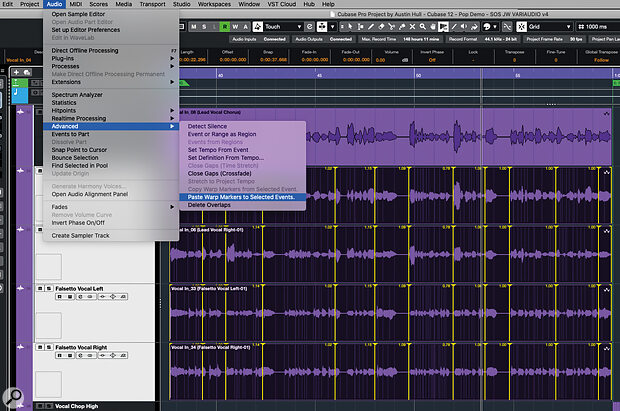 The AudioWarp system has been significantly upgraded, with operation within the Project window, phase‑coherent multitrack warping, and the ability to copy/paste Warp Markers between events.
The AudioWarp system has been significantly upgraded, with operation within the Project window, phase‑coherent multitrack warping, and the ability to copy/paste Warp Markers between events.
Second, Project‑window AudioWarp editing is also possible with Group Editing enabled, and now offers Phase Coherent AudioWarp (engaged via a button found in the Group’s Folder header within the Inspector). This is ideal when editing multi‑microphone recordings such as those from an acoustic drum kit. Warp Markers added to one track automatically appear in all the other tracks within the group and, when you edit a marker in one track, the corresponding marker in the other tracks moves in sync, maintaining the phase coherence. This makes for very slick drum editing.
Third, you can now copy the Warp Markers from one audio event and apply them to another. There are a number of contexts in which this might be useful, but the obvious example is with multitrack vocals and backing vocals. For example, you might perform some VariAudio editing on a lead vocal part. You can then copy the Warp Markers from this event, select the backing vocal events, and then paste the Warp Markers into your various backing vocal events. The markers get added, and AudioWarp automatically applies the same timing adjustments to your backing vocals. Providing the BVs were in time with the original lead vocal, they will now also match the lead vocal’s revised (warped) timing.
In practice, all these new features are very easy to use and, if this kind of editing is a regular part of your workflow, you will undoubtedly see some efficiency gains.
And There’s More...
While the above may represent some highlights of the new release, it’s not an exhaustive list. Space precludes a detailed look at everything, but a number of other improvements deserve a mention. For example, amongst workflow enhancements scattered throughout v12, we get some very useful new options in handling and editing crossfades (including a significant improvement in the crossfade editor window). New key commands are added for various nudge functions, the Range Selection tool and when slip editing audio. Volume automation has also been enhanced to provide near sample‑accurate resolution. In addition, within the Sample Track, you can now use the AudioWarp option with sliced audio mode.
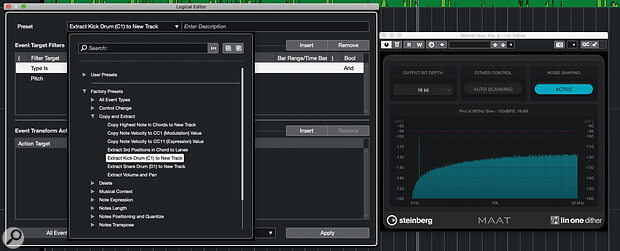 An upgrade to the Logical Editor system and a new dithering plug‑in are amongst a host of other additions and improvements in the v12 update.
An upgrade to the Logical Editor system and a new dithering plug‑in are amongst a host of other additions and improvements in the v12 update.
There are also improvements for ARA extensions such as SpectraLayers or Melodyne. These can now be inserted at track level as well as event level, and this makes for a more efficient workflow. And while the Logical Editor system is a somewhat intimidating mystery to some Cubase users, v12 sees some considerable enhancements to its capabilities and a much‑expanded collection of presets. It might still be a little scary, but it is also more powerful and well worth exploring. Oh, and very welcome for those who have to generate multiple stems from their mix projects, for Pro users, Audio Export now includes features that take sidechain processing into account when generating stems.
A new and more capable dither plug‑in, Lin One Dither, is also available, and support for the increasingly popular Dolby Atmos format is promised shortly in an upcoming maintenance release. Media composers now get a second video track — ideal when the director supplies you with all those last‑minute changes to the video cut! Finally, and a personal favourite amongst a few new additions to SuperVision’s module list, as shown in the opening main screenshot, we now get a VU meter with customisation of the meter’s response and a good selection of scale presets.
I’ve undoubtedly missed a number of other new additions but, before wrapping up, I ought to also mention something that, alongside the dongle, has also disappeared. Some of Steinberg’s older synths that were present within v11 — for example, Prologue, Spector or LoopMash — seem to have bitten the dust with v12, even if you are upgrading from v11, although the LoopMash FX plug‑in is still present. Thankfully, if you have older projects using these instruments, upgrading to v12 does leave v11 intact, so you can still open those projects in v11. I’ll perhaps miss LoopMash (the others are easily surpassed by Padshop and Retrologue) but I do wonder whether Steinberg might relight that particular fire at some stage.
Cubase Pro was already a powerhouse of an application. Steinberg have simply given it the bigger, better, faster, more treatment. Cubase Pro 12 is fabulous.
Conclusion
As someone who is part of the Cubase user base (Cubase Pro sits at the heart of my own project studio), I think Steinberg have done an excellent job with the v12 update. In a commercial context, the £85$99 upgrade price for Pro is a modest investment, yet it brings a significant number of new features that deliver obvious workflow enhancements in some very common recording and mixing tasks. Whether it’s the ability to extract the chords from an audio recording and begin populating the Chord Track, the ease with which you can edit the timing of multichannel audio recordings, the ability to edit pitch in vocal/solo instrument tracks without having to think about keeping things in the appropriate key/scale, or the tighter integration of your MIDI controller hardware with almost any aspect of Cubase, it’s all part of a more efficient workflow. And, on top of the workflow enhancements, there is also a number of new creative additions, such as new sounds from Verve and new processing options via FX Modulator and Raiser. Users working in almost any musical genre could benefit from many of these changes; it’s a lot of evolution for a pretty modest outlay.
Yes, for a brand‑new user, Pro’s asking price is a significant investment but, equally, Cubase Pro 12 is exactly what its name suggests: a music production platform capable of handling recording and mixing duties in a fully commercial, professional working environment. And, while not all the bells and whistles are included within the Artist and Elements versions (there is a comprehensive comparison of the respective feature sets on the Steinberg website), they provide a more affordable route into the Cubase family with sensible upgrade paths to Pro should that be required. And, as mentioned earlier, with Cubase 12’s new dongle‑free, licensing system, you are also soon going to be able to download a free, 30‑day trial version before committing to a purchase.
Cubase Pro was already a powerhouse of an application. Steinberg have simply given it the bigger, better, faster, more treatment. Cubase Pro 12 is fabulous.
Verve: Feel The Felt
 The new Verve instrument for Halion Sonic sounds fabulous — and note also the new panel open at the top of the UI, where you can select assignments for the plug‑in‑specific Quick Controls.
The new Verve instrument for Halion Sonic sounds fabulous — and note also the new panel open at the top of the UI, where you can select assignments for the plug‑in‑specific Quick Controls.
New for both Pro and Artist users is Verve. This virtual instrument combines very detailed sampling of a felt piano (a layer of felt sits between the hammers and the strings creating a softer, more intimate sound) with a second layer provided by a sustained texture from a selection of 60+ options. The instrument runs within Halion Sonic 3 (including SE) and the bespoke UI lets you adjust the balance between the two layers, tweak various parameters for each layer, and also apply delay and reverb effects.
On its own, the solo piano is both beautiful and expressive. The Distance control allows you to adjust the balance between the close and distant microphones used in the sampling process, giving you control over the natural ambience. The textures cover a fairly wide range of tones, from soft breathy sounds and various types of strings to sounds with metal ovetones, dreamy pulses and warm pad‑like options. However, they are all fairly subtle (no raging EDM here) as befits the instrument’s intention. For soft pop ballads, cinematic moods spanning dreamy love, sad reflective melancholy, or slightly sinister dark suspense, Verve can be just the thing. The combination of a soft piano and a pad texture is perhaps not a new one, but that doesn’t stop Verve sounding absolutely fantastic.
Pros
- A whole stream of really useful workflow enhancements.
- Excellent new creative additions including Verve, FX Modulator and Raiser.
- No dongle required.
Cons
- Some older virtual instruments have dropped from the line‑up.
Summary
Aside from losing the dongle, Cubase Pro 12 delivers a huge number of workflow enhancements that will benefit a wide cross‑section of the user base, and also adds some very useful creative options. This is a very impressive update.
Information
Cubase Pro 12 £497, upgrades from £85. Prices include VAT.
Cubase Pro 12 $579.99, upgrades from $99.99.
Test Spec
- Cubase Pro 12.0.0.
- Apple iMac, OS 10.15.7, 3.5GHz Intel Core i7, 32GB RAM.

